Japan Railways Locomotive Numbering And Classification on:
[Wikipedia]
[Google]
[Amazon]
This page explains the numbering and classification schemes for
 Prior to the nationalization of Japanese railways in 1906 and 1907, the government-run railways had numbered their
Prior to the nationalization of Japanese railways in 1906 and 1907, the government-run railways had numbered their
 Following the railway nationalization, in 1909, the railway authority adopted a new system in which locomotives were numbered and classified by four-digit numerals. All existing locomotives were reclassified. Numbers 1 through 4999 were allocated for tank locomotives and 5000 through 9999 were allocated for tender locomotives. Here the classes and the numbers acquired a distinct relationship. Locomotives were grouped in numbers and the classes were represented by the earliest number of the group.
*1–999 – Tank locomotives with two driving axles
*1000–3999 – Tank locomotives with three driving axles (3900 and after for rack railway)
*4000–4999 – Tank locomotives with four driving axles
*5000–6999 – Tender locomotives with two driving axles
*7000–8999 – Tender locomotives with three driving axles
*9000–9999 – Tender locomotives with four and over driving axles
Numbers within a class were serial in principle. When the number overflowed (as in Classes 8620, 9600 and 9900), one digit was added to precede the four digits to make the numbers five digit. Class 18900 (later reclassified as Class C51) was exceptionally five digit from the beginning.
This numbering and classification rule survived the revision in 1928. Non-standard locomotives that joined the national railways by means of purchase of railway companies were numbered in accordance with this rule even after 1928. Locomotives numbered and classified under this rule includes the locomotives used until very last days of JNR steam locomotives in the 1970s.
Following the railway nationalization, in 1909, the railway authority adopted a new system in which locomotives were numbered and classified by four-digit numerals. All existing locomotives were reclassified. Numbers 1 through 4999 were allocated for tank locomotives and 5000 through 9999 were allocated for tender locomotives. Here the classes and the numbers acquired a distinct relationship. Locomotives were grouped in numbers and the classes were represented by the earliest number of the group.
*1–999 – Tank locomotives with two driving axles
*1000–3999 – Tank locomotives with three driving axles (3900 and after for rack railway)
*4000–4999 – Tank locomotives with four driving axles
*5000–6999 – Tender locomotives with two driving axles
*7000–8999 – Tender locomotives with three driving axles
*9000–9999 – Tender locomotives with four and over driving axles
Numbers within a class were serial in principle. When the number overflowed (as in Classes 8620, 9600 and 9900), one digit was added to precede the four digits to make the numbers five digit. Class 18900 (later reclassified as Class C51) was exceptionally five digit from the beginning.
This numbering and classification rule survived the revision in 1928. Non-standard locomotives that joined the national railways by means of purchase of railway companies were numbered in accordance with this rule even after 1928. Locomotives numbered and classified under this rule includes the locomotives used until very last days of JNR steam locomotives in the 1970s.
 ; Example: D51 498
Unlike electric and diesel locomotives, steam locomotive classifications do not include an indication of the type of power source (steam) in their class names.
; Number of driving axles
:A letter indicates the number of driving axles. Number of either leading and trailing axles or axles of tenders is disregarded.
:* 2 axles – B
:* 3 axles – C
:* 4 axles – D
:* 5 axles – E
; Class
: Together with the letter representing the number of driving axles, a two-digit numeral following the letter indicates a class. The number distinguishes tank locomotives and tender locomotives.
:* 10–49 – Tank locomotives
:* 50–99 – Tender locomotives
According to this numbering method, D51 498 means locomotive number 498 of Class D51, which is a class of tender locomotives with four driving axles.
; Example: D51 498
Unlike electric and diesel locomotives, steam locomotive classifications do not include an indication of the type of power source (steam) in their class names.
; Number of driving axles
:A letter indicates the number of driving axles. Number of either leading and trailing axles or axles of tenders is disregarded.
:* 2 axles – B
:* 3 axles – C
:* 4 axles – D
:* 5 axles – E
; Class
: Together with the letter representing the number of driving axles, a two-digit numeral following the letter indicates a class. The number distinguishes tank locomotives and tender locomotives.
:* 10–49 – Tank locomotives
:* 50–99 – Tender locomotives
According to this numbering method, D51 498 means locomotive number 498 of Class D51, which is a class of tender locomotives with four driving axles.
 The table below lists all classes of the electric locomotives identified under this method.
The table below lists all classes of the electric locomotives identified under this method.
 ; Example: EF81 95
; E
:All classes of electric locomotives begin with the letter "E" for "electric".
; Number of driving axles
:A letter indicates the number of driving axles. Unpowered axles are disregarded.
:* 2 axles – B
:* 3 axles – C
:* 4 axles – D
:* 6 axles – F
:* 8 axles – H
; Class
:Together with the letter "E" and the letter representing the number of driving axles, a two-digit numeral following the letters indicates a class. Originally, the number distinguished the three types of locomotives.
:* 10–39 - Locomotives with maximum speed 85 km/h or less
:* 40–49 - Locomotives for rack railway
:* 50–99 - Locomotives with maximum speed exceeding 85 km/h
:As a result of a revision, as of 1987, the rule was as follows.
:* 10–29 - DC locomotives with maximum speed 85 km/h or less
:* 30–39 - AC/DC locomotives with maximum speed 85 km/h or less
:* 40–49 - AC locomotives with maximum speed 85 km/h or less
:* 50–69 - DC locomotives with maximum speed exceeding 85 km/h
:* 70–79 - AC locomotives with maximum speed exceeding 85 km/h
:* 80–89 - AC/DC locomotives with maximum speed exceeding 85 km/h
:* 90–99 - prototypes
; Running number
: In principle, running numbers begin with 1. However, numbers may be skipped to create subclasses, such as Class EF65 1000 or Class ED75 700.
According to this numbering method, EF81 95 means locomotive number 95 of Class EF81, which is a class of AC/DC locomotive with six driving axles and maximum speed exceeding 85 km/h.
; Example: EF81 95
; E
:All classes of electric locomotives begin with the letter "E" for "electric".
; Number of driving axles
:A letter indicates the number of driving axles. Unpowered axles are disregarded.
:* 2 axles – B
:* 3 axles – C
:* 4 axles – D
:* 6 axles – F
:* 8 axles – H
; Class
:Together with the letter "E" and the letter representing the number of driving axles, a two-digit numeral following the letters indicates a class. Originally, the number distinguished the three types of locomotives.
:* 10–39 - Locomotives with maximum speed 85 km/h or less
:* 40–49 - Locomotives for rack railway
:* 50–99 - Locomotives with maximum speed exceeding 85 km/h
:As a result of a revision, as of 1987, the rule was as follows.
:* 10–29 - DC locomotives with maximum speed 85 km/h or less
:* 30–39 - AC/DC locomotives with maximum speed 85 km/h or less
:* 40–49 - AC locomotives with maximum speed 85 km/h or less
:* 50–69 - DC locomotives with maximum speed exceeding 85 km/h
:* 70–79 - AC locomotives with maximum speed exceeding 85 km/h
:* 80–89 - AC/DC locomotives with maximum speed exceeding 85 km/h
:* 90–99 - prototypes
; Running number
: In principle, running numbers begin with 1. However, numbers may be skipped to create subclasses, such as Class EF65 1000 or Class ED75 700.
According to this numbering method, EF81 95 means locomotive number 95 of Class EF81, which is a class of AC/DC locomotive with six driving axles and maximum speed exceeding 85 km/h.
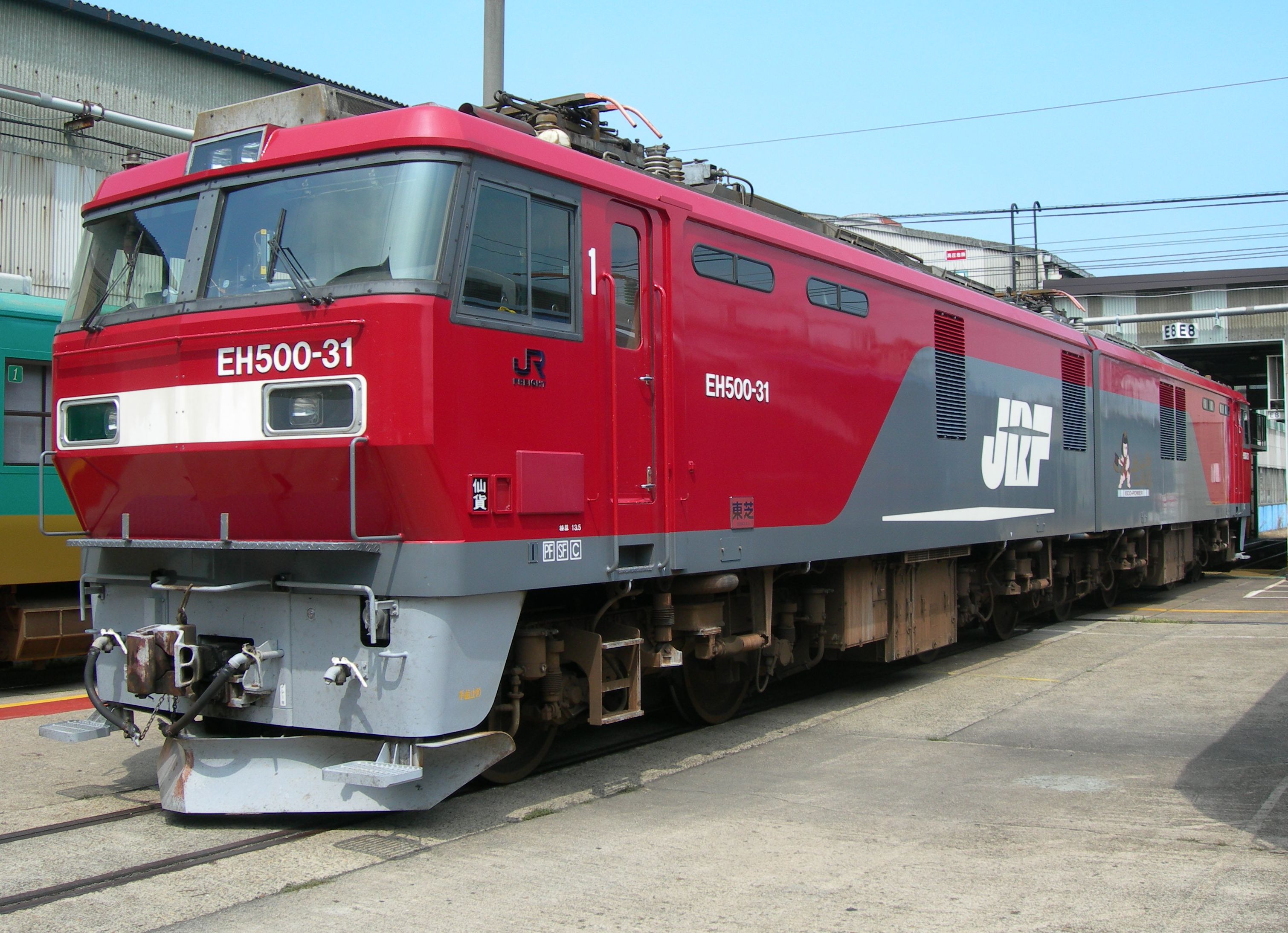 ;Example: EH500-31
Usage of Roman letters is the same as the 1928 rule. A hyphen is placed between the class number and running number.
; Class
: Three digits of numerals are used to indicate classes. The classification by the maximum speed was replaced by the classification by the types of
;Example: EH500-31
Usage of Roman letters is the same as the 1928 rule. A hyphen is placed between the class number and running number.
; Class
: Three digits of numerals are used to indicate classes. The classification by the maximum speed was replaced by the classification by the types of
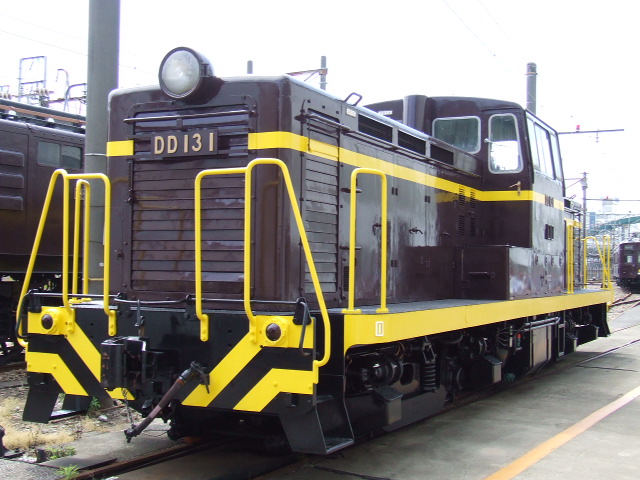 ; Example : DD13 1
; D
:All classes of diesel locomotives begin with the letter "D" for "Diesel".
; Example : DD13 1
; D
:All classes of diesel locomotives begin with the letter "D" for "Diesel".
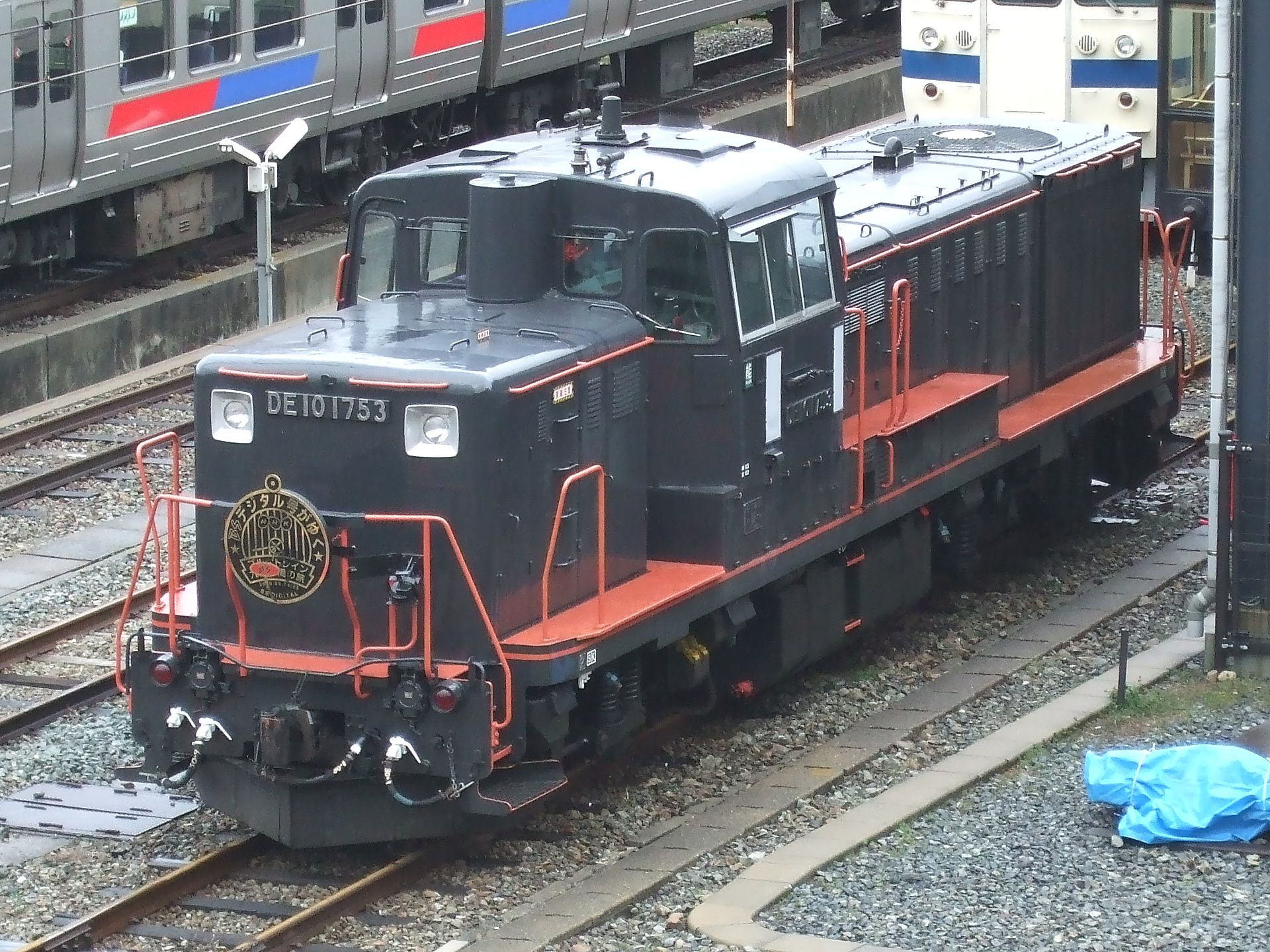 ; Number of driving axles
: A letter indicates the number of driving axles. Unpowered axles are disregarded.
:* 3 axles – C
:* 4 axles – D
:* 5 axles – E
:* 6 axles – F
; Class
: Together with the letter "D" and the letter representing the number of driving axles, a two-digit numeral following the letters indicates a class. The number distinguishes the locomotives by the maximum speeds.
:* 10–39 - Locomotives with maximum speed 85 km/h or less
:* 40–49 - Prototypes
:* 50–89 - Locomotives with maximum speed exceeding 85 km/h
:* 90–99 - Prototypes
; Running number
: Same as for electric locomotives.
According to this numbering method, DD13 1 means locomotive number 1 of Class DD13, which is a class of diesel locomotive with four driving axles and maximum speed 85 km/h or less.
; Number of driving axles
: A letter indicates the number of driving axles. Unpowered axles are disregarded.
:* 3 axles – C
:* 4 axles – D
:* 5 axles – E
:* 6 axles – F
; Class
: Together with the letter "D" and the letter representing the number of driving axles, a two-digit numeral following the letters indicates a class. The number distinguishes the locomotives by the maximum speeds.
:* 10–39 - Locomotives with maximum speed 85 km/h or less
:* 40–49 - Prototypes
:* 50–89 - Locomotives with maximum speed exceeding 85 km/h
:* 90–99 - Prototypes
; Running number
: Same as for electric locomotives.
According to this numbering method, DD13 1 means locomotive number 1 of Class DD13, which is a class of diesel locomotive with four driving axles and maximum speed 85 km/h or less.
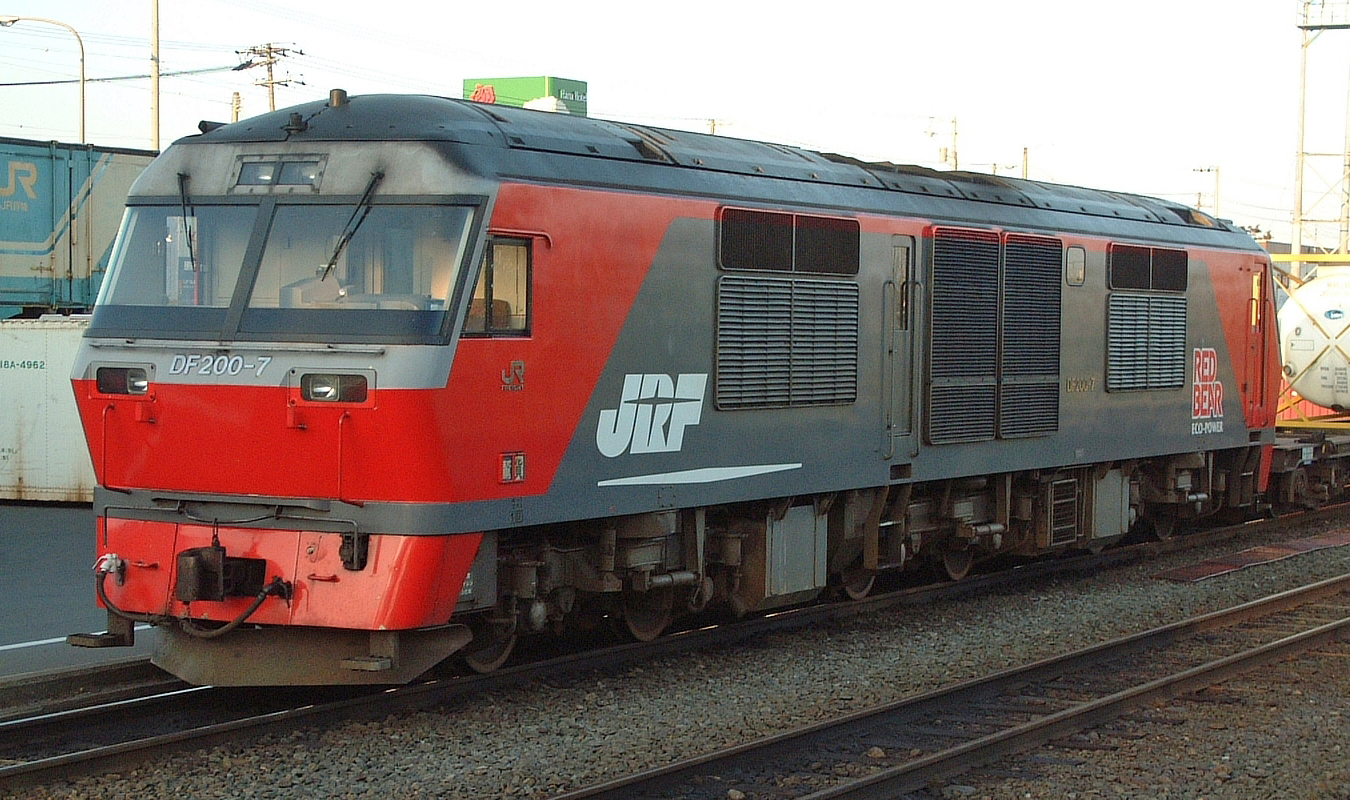 ; Example : DF200-7
Usage of Roman letters is the same as for JNR usage. A hyphen is placed between the class number and running number.
; Class
: Three digits of numerals are used to indicate classes. The classification by the maximum speed was replaced by the classification by the forms of power transmission and types of electric motors in case of diesel-electric locomotives.
:* 100–199 - Diesel-electric locomotives with DC motors
:* 200–299 - Diesel-electric locomotives with AC motors
:* 300–399 - Other diesel-electric locomotives
:* 500–799 - Diesel-hydraulic locomotives
According to this numbering method, DF200-7 means locomotive number 7 of Class DF200, which is a class of diesel-electric locomotive with six driving axles and AC electric motors.
; Example : DF200-7
Usage of Roman letters is the same as for JNR usage. A hyphen is placed between the class number and running number.
; Class
: Three digits of numerals are used to indicate classes. The classification by the maximum speed was replaced by the classification by the forms of power transmission and types of electric motors in case of diesel-electric locomotives.
:* 100–199 - Diesel-electric locomotives with DC motors
:* 200–299 - Diesel-electric locomotives with AC motors
:* 300–399 - Other diesel-electric locomotives
:* 500–799 - Diesel-hydraulic locomotives
According to this numbering method, DF200-7 means locomotive number 7 of Class DF200, which is a class of diesel-electric locomotive with six driving axles and AC electric motors.
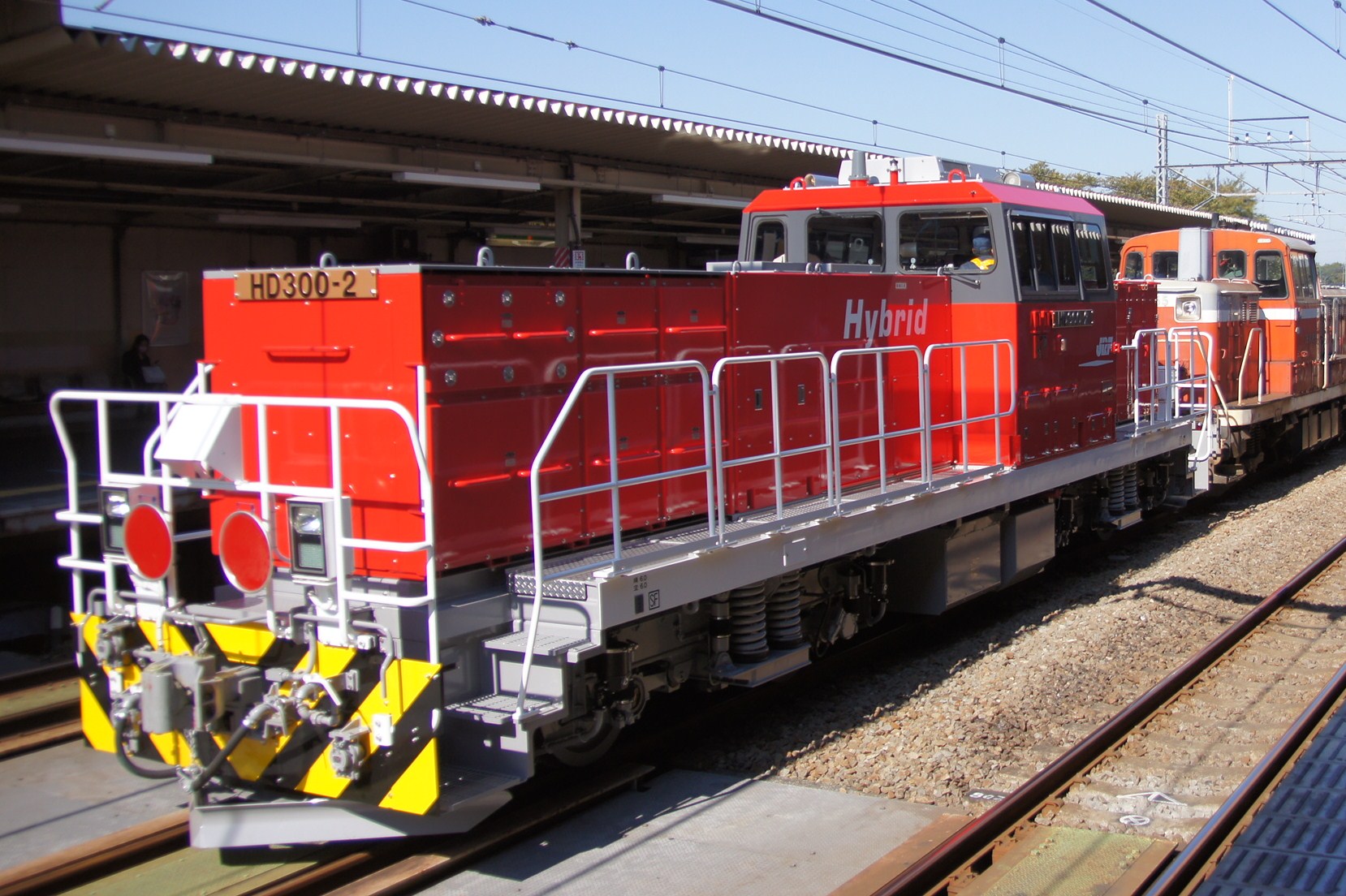 In 2010, JR Freight classified its first diesel-battery hybrid locomotive HD300. The class name HD300 was explained as follows.
In 2010, JR Freight classified its first diesel-battery hybrid locomotive HD300. The class name HD300 was explained as follows."新型入換専用機関車(試作)の形式名とデザインについて" (Class name and design of new switcher locomotive prototype), JR Freight news release, February 10, 2010
Retrieved on February 10, 2010. *H - hybrid locomotive *D - number of driving axles being four *300 - type of main motor being
Exhibition of Railway Museum: Number Plate
{{Reflist
Locomotive classification systems Locomotives of Japan
locomotive
A locomotive or engine is a rail transport vehicle that provides the Power (physics), motive power for a train. If a locomotive is capable of carrying a payload, it is usually rather referred to as a multiple unit, Motor coach (rail), motor ...
s employed by the Japanese Government Railways
The Japanese Government Railways (JGR) was the national railway system directly operated by the Japanese Ministry of Railways ( ja, 鉄道省, Tetsudō-shō, ) until 1949. It was a predecessor of Japanese National Railways and the later Japan Rai ...
, the Japanese National Railways
The abbreviated JNR or , was the business entity that operated Japan's national railway network from 1949 to 1987.
Network Railways
As of June 1, 1949, the date of establishment of JNR, it operated of narrow gauge () railways in all 46 pref ...
and the Japan Railways Group
The Japan Railways Group, more commonly known as the or simply JR, consists of seven for-profit stock companies that took over most of the assets and operations of the government-owned Japanese National Railways (JNR) on April 1, 1987. Mo ...
.
Steam locomotives
Pre-nationalization
 Prior to the nationalization of Japanese railways in 1906 and 1907, the government-run railways had numbered their
Prior to the nationalization of Japanese railways in 1906 and 1907, the government-run railways had numbered their steam locomotive
A steam locomotive is a locomotive that provides the force to move itself and other vehicles by means of the expansion of steam. It is fuelled by burning combustible material (usually coal, oil or, rarely, wood) to heat water in the locomot ...
s only with serial numbers without consideration of the types of the locomotives. From the beginning of the Kobe–Osaka railway in 1874, they allocated odd numbers to locomotives in Tokyo area and even numbers to locomotives in Kobe area, but this custom was not maintained after the completion of railway between Tokyo and Kobe in 1889. Later, some locomotives, such as Classes A8 and B6 and rack railway
A rack railway (also rack-and-pinion railway, cog railway, or cogwheel railway) is a steep grade railway with a toothed rack rail, usually between the running rails. The trains are fitted with one or more cog wheels or pinions that mesh with ...
locomotives, were renumbered to make groups for easy recognition of classes.
Classes were introduced by Francis H. Trevithick (1850–1931), a grandson of Richard Trevithick
Richard Trevithick (13 April 1771 – 22 April 1833) was a British inventor and mining engineer. The son of a mining captain, and born in the mining heartland of Cornwall, Trevithick was immersed in mining and engineering from an early age. He w ...
, employed by the government of Japan for supervision of rolling stock management. He classified the locomotives with one Latin letter
The Latin script, also known as Roman script, is an alphabetic writing system based on the letters of the classical Latin alphabet, derived from a form of the Greek alphabet which was in use in the ancient Greek city of Cumae, in southern Ital ...
(A through Z), which was then expanded to use two letters (AB, AC, AD, and so on).
Later, this simple method was revised to use one letter and one or two digit numerals with consideration of locomotive types. The meanings of the letters were as follows:
*A – Tank locomotive
A tank locomotive or tank engine is a steam locomotive that carries its water in one or more on-board water tanks, instead of a more traditional tender. Most tank engines also have bunkers (or fuel tanks) to hold fuel; in a tender-tank locom ...
s with two driving axles (A1–A10)
*B – Tank locomotives with three driving axles (B1–B7)
*C – Tank locomotives for rack railway (C1–C3)
*D – Tender locomotive
A tender or coal-car (US only) is a special rail vehicle hauled by a steam locomotive containing its fuel (wood, coal, oil or torrefied biomass) and water. Steam locomotives consume large quantities of water compared to the quantity of fuel, so ...
s with two driving axles (D1–D12)
*E – Tender locomotives with three driving axles (E1–E7)
*F – Tender locomotives with four driving axles (F1–F2)
1909 numbering system
1928 numbering system
Because the 1909 method was about to overflow, a new system of numbering and classification came into effect on October 1, 1928. Except for Classes 18900, 8200 and 9900 being reclassified as C51, C52 and D50 respectively, existing locomotives were not reclassified or renumbered. After this revision, steam locomotives were classified and numbered with a Latin letter and numerals. ; Example: D51 498
Unlike electric and diesel locomotives, steam locomotive classifications do not include an indication of the type of power source (steam) in their class names.
; Number of driving axles
:A letter indicates the number of driving axles. Number of either leading and trailing axles or axles of tenders is disregarded.
:* 2 axles – B
:* 3 axles – C
:* 4 axles – D
:* 5 axles – E
; Class
: Together with the letter representing the number of driving axles, a two-digit numeral following the letter indicates a class. The number distinguishes tank locomotives and tender locomotives.
:* 10–49 – Tank locomotives
:* 50–99 – Tender locomotives
According to this numbering method, D51 498 means locomotive number 498 of Class D51, which is a class of tender locomotives with four driving axles.
; Example: D51 498
Unlike electric and diesel locomotives, steam locomotive classifications do not include an indication of the type of power source (steam) in their class names.
; Number of driving axles
:A letter indicates the number of driving axles. Number of either leading and trailing axles or axles of tenders is disregarded.
:* 2 axles – B
:* 3 axles – C
:* 4 axles – D
:* 5 axles – E
; Class
: Together with the letter representing the number of driving axles, a two-digit numeral following the letter indicates a class. The number distinguishes tank locomotives and tender locomotives.
:* 10–49 – Tank locomotives
:* 50–99 – Tender locomotives
According to this numbering method, D51 498 means locomotive number 498 of Class D51, which is a class of tender locomotives with four driving axles.
Electric locomotives
Pre-1928 numbering system
The national railways imported its firstelectric locomotive
An electric locomotive is a locomotive powered by electricity from overhead lines, a third rail or on-board energy storage such as a battery or a supercapacitor. Locomotives with on-board fuelled prime movers, such as diesel engines or gas ...
s in 1912. Like steam locomotives of that period, electric locomotives were numbered with four or five digit numerals. Classes were represented by their earliest numbers, last digit being "0".
 The table below lists all classes of the electric locomotives identified under this method.
The table below lists all classes of the electric locomotives identified under this method.
1928 numbering system
A new system of numbering and classification came into effect in 1928. Originally, electric locomotives were classified by maximum speeds. High-speed locomotives were for passenger trains and low-speed locomotives were for freight trains. Later, the system was revised to distinguish the types of electricity when AC and AC/ DC locomotives were introduced.JR Freight
Out of sevenJapan Railways Group
The Japan Railways Group, more commonly known as the or simply JR, consists of seven for-profit stock companies that took over most of the assets and operations of the government-owned Japanese National Railways (JNR) on April 1, 1987. Mo ...
(JR Group) companies established in 1987, only Japan Freight Railway Company
, or , is one of the seven constituent companies of Japan Railways Group (JR Group). It provides transportation of cargo nationwide throughout Japan. Its headquarters are in Shibuya, Tokyo near Shinjuku Station.
The Japan Railways Group was foun ...
(JR Freight) has built new electric locomotives. Initially JR Freight continued to build locomotives originally designed by JNR with minor modifications. However, in 1990, it created the new class of EF200, adopting a new classification system with three-digit class names. This system was also later adopted by East Japan Railway Company
The is a major passenger railway company in Japan and is the largest of the seven Japan Railways Group companies. The company name is officially abbreviated as JR-EAST or JR East in English, and as in Japanese. The company's headquarters are ...
(JR East) when it introduced its version of the Class EF510 in 2010.
 ;Example: EH500-31
Usage of Roman letters is the same as the 1928 rule. A hyphen is placed between the class number and running number.
; Class
: Three digits of numerals are used to indicate classes. The classification by the maximum speed was replaced by the classification by the types of
;Example: EH500-31
Usage of Roman letters is the same as the 1928 rule. A hyphen is placed between the class number and running number.
; Class
: Three digits of numerals are used to indicate classes. The classification by the maximum speed was replaced by the classification by the types of motors
An engine or motor is a machine designed to convert one or more forms of energy into mechanical energy.
Available energy sources include potential energy (e.g. energy of the Earth's gravitational field as exploited in hydroelectric power g ...
.
:* 100–199 - DC locomotives with DC motors
:* 200–299 - DC locomotives with AC motors
:* 300–399 - Other DC locomotives
:* 400–499 - AC/DC locomotives with DC motors
:* 500–599 - AC/DC locomotives with AC motors
:* 600–699 - Other AC/DC locomotives
:* 700–799 - AC locomotives with DC motors
:* 800–899 - AC locomotives with AC motors
:* 900–999 - Other AC locomotives
According to this numbering method, EH500-31 means locomotive number 31 of Class EH500
The is a Bo′Bo′+Bo′Bo′ wheel arrangement multi-system AC/ DC two-unit electric locomotive type operated by JR Freight in Japan since 1997.
Operations
The locomotives are built at the Toshiba factory in Fuchū, Tokyo. Initially, they w ...
, which is a class of AC/DC locomotive with eight driving axles and AC motors.
Diesel locomotives
JNR
The history ofdiesel locomotive
A diesel locomotive is a type of railway locomotive in which the prime mover is a diesel engine. Several types of diesel locomotives have been developed, differing mainly in the means by which mechanical power is conveyed to the driving whee ...
s of the Japanese Government Railways started with two classes of German-made locomotives, the diesel-electric Class DC11 in 1929 and the diesel-mechanical DC10 in 1930. The Ministry of Railways numbered them in accordance with the similar system as it then used for steam and electric locomotives. The Japanese National Railways continued with this system.
 ; Example : DD13 1
; D
:All classes of diesel locomotives begin with the letter "D" for "Diesel".
; Example : DD13 1
; D
:All classes of diesel locomotives begin with the letter "D" for "Diesel".
 ; Number of driving axles
: A letter indicates the number of driving axles. Unpowered axles are disregarded.
:* 3 axles – C
:* 4 axles – D
:* 5 axles – E
:* 6 axles – F
; Class
: Together with the letter "D" and the letter representing the number of driving axles, a two-digit numeral following the letters indicates a class. The number distinguishes the locomotives by the maximum speeds.
:* 10–39 - Locomotives with maximum speed 85 km/h or less
:* 40–49 - Prototypes
:* 50–89 - Locomotives with maximum speed exceeding 85 km/h
:* 90–99 - Prototypes
; Running number
: Same as for electric locomotives.
According to this numbering method, DD13 1 means locomotive number 1 of Class DD13, which is a class of diesel locomotive with four driving axles and maximum speed 85 km/h or less.
; Number of driving axles
: A letter indicates the number of driving axles. Unpowered axles are disregarded.
:* 3 axles – C
:* 4 axles – D
:* 5 axles – E
:* 6 axles – F
; Class
: Together with the letter "D" and the letter representing the number of driving axles, a two-digit numeral following the letters indicates a class. The number distinguishes the locomotives by the maximum speeds.
:* 10–39 - Locomotives with maximum speed 85 km/h or less
:* 40–49 - Prototypes
:* 50–89 - Locomotives with maximum speed exceeding 85 km/h
:* 90–99 - Prototypes
; Running number
: Same as for electric locomotives.
According to this numbering method, DD13 1 means locomotive number 1 of Class DD13, which is a class of diesel locomotive with four driving axles and maximum speed 85 km/h or less.
JR Freight
After the privatization of JNR in 1987, two Japan Railways Group (JR Group) companies created new classes of diesel locomotives.East Japan Railway Company
The is a major passenger railway company in Japan and is the largest of the seven Japan Railways Group companies. The company name is officially abbreviated as JR-EAST or JR East in English, and as in Japanese. The company's headquarters are ...
(JR East) classified its new class as DD19, using the JNR classification system, as it was only a rebuild of the Class DD17, which was built by JNR. On the other hand, Japan Freight Railway Company (JR Freight) built completely new diesel locomotives, which were classified using a new system with three-digit class names.
 ; Example : DF200-7
Usage of Roman letters is the same as for JNR usage. A hyphen is placed between the class number and running number.
; Class
: Three digits of numerals are used to indicate classes. The classification by the maximum speed was replaced by the classification by the forms of power transmission and types of electric motors in case of diesel-electric locomotives.
:* 100–199 - Diesel-electric locomotives with DC motors
:* 200–299 - Diesel-electric locomotives with AC motors
:* 300–399 - Other diesel-electric locomotives
:* 500–799 - Diesel-hydraulic locomotives
According to this numbering method, DF200-7 means locomotive number 7 of Class DF200, which is a class of diesel-electric locomotive with six driving axles and AC electric motors.
; Example : DF200-7
Usage of Roman letters is the same as for JNR usage. A hyphen is placed between the class number and running number.
; Class
: Three digits of numerals are used to indicate classes. The classification by the maximum speed was replaced by the classification by the forms of power transmission and types of electric motors in case of diesel-electric locomotives.
:* 100–199 - Diesel-electric locomotives with DC motors
:* 200–299 - Diesel-electric locomotives with AC motors
:* 300–399 - Other diesel-electric locomotives
:* 500–799 - Diesel-hydraulic locomotives
According to this numbering method, DF200-7 means locomotive number 7 of Class DF200, which is a class of diesel-electric locomotive with six driving axles and AC electric motors.
Shinkansen
Diesel locomotives used on theShinkansen
The , colloquially known in English as the bullet train, is a network of high-speed railway lines in Japan. Initially, it was built to connect distant Japanese regions with Tokyo, the capital, to aid economic growth and development. Beyond l ...
system (for track maintenance and depot use) are numbered with three-digit class names followed by a serial number connected with a hyphen. There have been two classes of diesel locomotives for shinkansen use: 911 and 912.
In the uniform classification system for Shinkansen rolling stock, the first digit 9 is assigned for cars and locomotives for departmental use. In this 9XX group, the second digit 1 is used for diesel locomotives.
Hybrid locomotives
Retrieved on February 10, 2010. *H - hybrid locomotive *D - number of driving axles being four *300 - type of main motor being
synchronous motor
A synchronous electric motor is an AC electric motor in which, at steady state,
the rotation of the shaft is synchronized with the frequency of the supply current; the rotation period is exactly equal to an integral number of AC cycles. Sync ...
References
Exhibition of Railway Museum: Number Plate
{{Reflist
Locomotive classification systems Locomotives of Japan